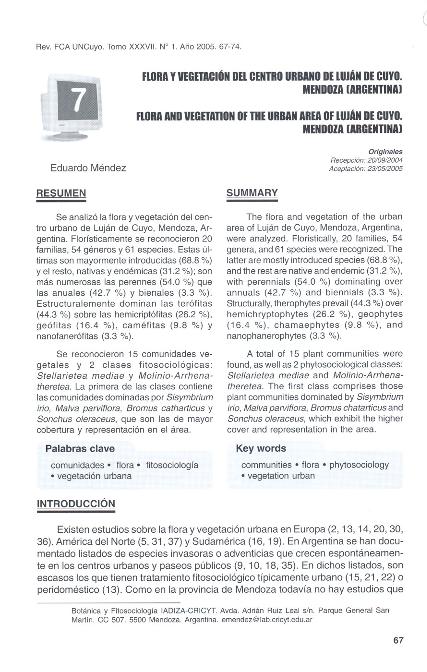Artículo
Se analizó la flora y vegetación del centro urbano de Luján de Cuyo, Mendoza, Argentina. Florísticamente se reconocieron 20 familias, 54 géneros y 61 especies. Estas últimas son mayormente introducidas (68.8 %) y el resto, nativas y endémicas (31.2 %); son más numerosas las perennes (54.0 %) que las anuales (42.7 %) y bienales (3.3 %). Estructuralemente dominan las terófitas (44.3 %) sobre las hemicriptófitas (26.2 %), geófitas (16.4 %), caméfitas (9.8 %) y nanofanerófitas (3.3 %). Se reconocieron 15 comunidades vegetales y 2 clases fitosociológicas: Stellarietea mediae y Molinio-Arrhenatheretea. La primera de las clases contiene las comunidades dominadas por Sisymbrium irio, Malva parviflora, Bromus catharticus y Sonchus oleraceus, que son las de mayor cobertura y representación en el área. The flora and vegetation of the urban area of Luján de Cuyo, Mendoza, Argentina, were analyzed. Floristically, 20 families, 54 genera, and 61 species were recognized. The latter are mostly introduced species (68.8 %), and the rest are native and endemic (31.2 %), with perennials (54.0 %) dominating over annuals (42.7 %) and biennials (3.3 %). Structurally, therophytes prevail (44.3 %) over hemichryptophytes (26.2 %), geophytes (16.4 %), chamaephytes (9.8 %), and nanophanerophytes (3.3 %). A total of 15 plant communities were found, as well as 2 phytosociological classes: Stellarietea mediae and Molinio-Arrhenatheretea. The first class comprises those plant communities dominated by Sisymbrium irio, Malva parviflora, Bromus chatarticus and Sonchus oleraceus, which exhibit the higher cover and representation in the area.
Flora y vegetación del centro urbano de Luján de Cuyo, Mendoza, Argentina
Título:
Flora anda vegetation of the urban area of Luján de Cuyo, Mendoza (Argentina)
Fecha de publicación:
12/2005
Editorial:
Universidad Nacional de Cuyo. Facultad de Ciencias Agrarias
Revista:
Revista Facultad de Ciencias Agrarias
ISSN:
0370-4661
Idioma:
Español
Tipo de recurso:
Artículo publicado
Clasificación temática:
Resumen
Palabras clave:
COMUNIDADES
,
FLORA
,
FITOSOCIOLOGÍA
,
VEGETACIÓN URBANA
Archivos asociados
Licencia
Identificadores
Colecciones
Articulos(IADIZA)
Articulos de INST. ARG DE INVEST. DE LAS ZONAS ARIDAS
Articulos de INST. ARG DE INVEST. DE LAS ZONAS ARIDAS
Citación
Mendez, Eduardo; Flora y vegetación del centro urbano de Luján de Cuyo, Mendoza, Argentina; Universidad Nacional de Cuyo. Facultad de Ciencias Agrarias; Revista Facultad de Ciencias Agrarias; 37; 1; 12-2005; 67-74
Compartir




